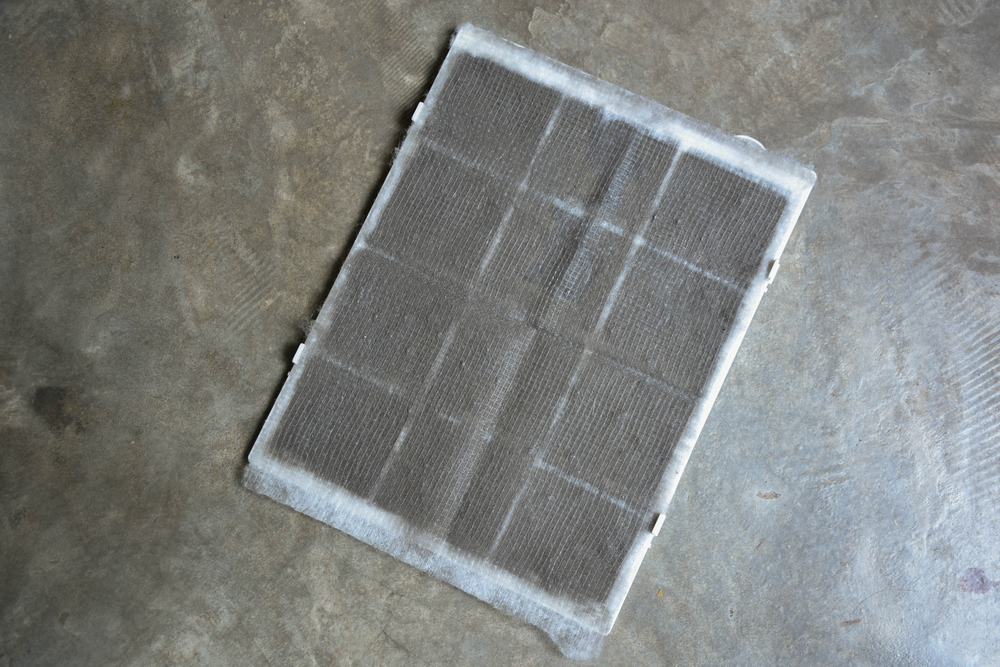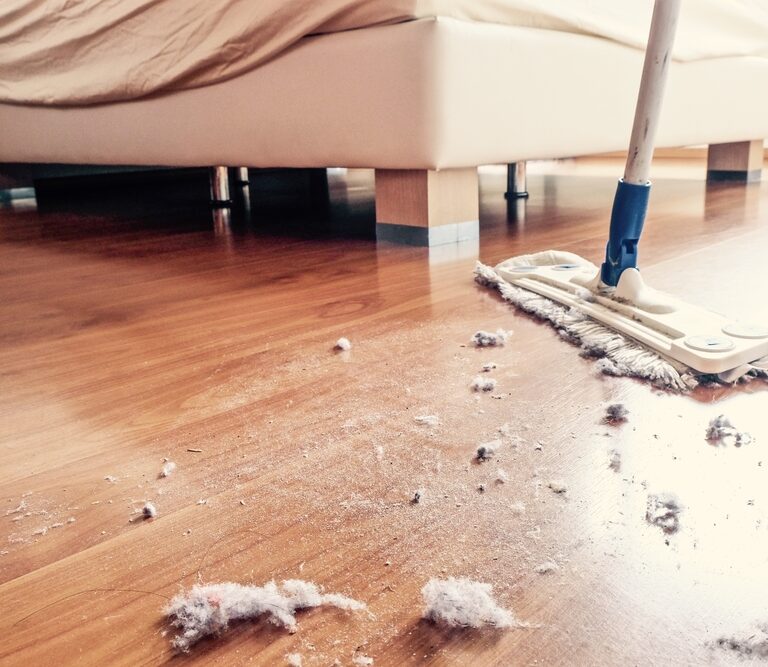No matter how much you clean your home, dust always seems to find its way in to dirty the place up. Dust not only creates the need for more cleaning, but it can impede the quality of the air in your home, and even bring in unwanted pests.
In order to minimize the dust in your home, you’ll need to understand what dust is, where it comes from, and how to effectively reduce the amount in your space.
What Is Dust, and Where Does It Come From?
Dust is a catch-all term for the admixture of the many particles and contaminants that permeate our homes and vehicles. They include not only the flakes of dead skin and hair, but also other microscopic environmental contaminants like pollen, soil, clothing fibers, and even plastic and metals.
These pollutants come from a variety of sources, from you and the various objects you use every day, to your workplace and the great outdoors. Dust clings to virtually any object, and especially loves to stick to fabrics, meaning no matter how clean you are, you’re always bringing in dust with you.
But it isn’t always just pesky and unsightly – it can be harmful too.
The Dangers of Dust
Dust can be harmful to your health, depending on the size and constituents of the dust you come in contact with. If you work in a manufacturing environment, for instance, your clothes may be carrying fine particles of plastic, metal, or other harmful substances that can negatively impact your long-term health.
However, for people with allergies and other respiratory issues, even relatively inert dust can cause problems. These problems can range from minor issues like sneezing, watery eyes, and skin irritation, to more severe problems like asthma attacks.
Dust can also attract dust mites, which feed on dead skin cells. Dust mites don’t bite, and aren’t inherently harmful themselves. Rather, they leave behind fecal matter that can trigger a reaction in people who are allergic to them, leading to minor to severe allergic reactions, including acute asthmatic reactions.
While you can’t completely rid your home of dust, you can take steps to reduce the amount of dust in your home.
How to Remove Dust From Your Home
In order to keep the dust in your home under control, you’ll need to do some dusting – a lot of it, actually. This means wiping down every surface in your home. However, you don’t want to use just any old rag for dusting, and you certainly want to avoid traditional feather dusters, which can kick up more dust than they take with them.
Instead, you’ll want to opt for microfiber. Because of the way microfiber is made, it is highly absorbent and has a greater surface area than traditional cleaning textiles. This allows it to grab and hold dust particles so that when you’re cleaning, the cloth will take the dust with it, rather than simply spreading it around.
Not only can you find microfiber cloths, but you can also find microfiber dusters to get those hard-to-reach areas. Microfiber dusters also work well for delicate surfaces, such as blinds and knickknacks.
Dusting Tip: When dusting your home, start from the top and work your way down. As you wipe higher surfaces, stray dust particles may drift off into the air and slowly settle to lower surfaces.
Removing Dust From Fabric Furniture
Fabric furniture is a warehouse for dust to settle into. Because of this, it’s important that when you’re cleaning, you address the textile elephants in the room.
Change Your Bedding
If your couch is a dust warehouse, then your bed is a dust factory. As you sleep, you shed dead skin particles that get trapped in the fibers of sheets, pillows and blankets. Washing your bedding on a weekly basis can help keep dust down.
If you’re worried about dust mites, you may also consider using hypoallergenic bedding. This can help keep dust mites at bay without taking your cleaning to an extreme level.
Vacuum Your Furniture
Unless you’ve outfitted your home with nothing but hard, cushion-less furniture, then you’ll want to regularly vacuum your furniture. This will help remove loose dust that can become airborne when you sit on your furniture.
If you suffer from allergies or respiratory problems, using a vacuum that has a HEPA filter. This will help you trap pollen and other allergens.
Grab a Lint Roller
If you have furry friends at home, then a lint roller is a must. Lint rollers use small strips of adhesive-backed paper you roll across fabrics. They come in a variety of sizes, from small handheld rollers to larger rollers with extended handles to cover bigger areas more easily.
But lint rollers aren’t just good for hair – they’re also a great way to keep the dust bunnies at bay. Using a lint roller between cleanings with your vacuum can help minimize the dust your furniture expels.
Removing Dust From Floors
Floors make up a majority of the surface area in most homes. Between that and frequent foot traffic, they are a commonplace for dust to reside, meaning you’ll need to clean them frequently to help keep dust in check.
Vacuum Carpets
Carpets are another safe-haven for dust to reside. Like fabric furniture, regular vacuuming is a must if you have carpeted floors and want to keep dust at bay.
Mop Your Floors
For hard floors, mopping is an essential way to keep your dust problem under control. Water is a great way to keep dust settled.
However, depending on the surface of your floor, you may want to avoid mopping with a liquid too frequently, or even altogether. If you have wood floors, you may opt to use a microfiber dust mop for frequent mopping, saving the liquids for occasional maintenance or deep cleaning.
Other hard floor surfaces, like tile and laminate flooring, may handle liquid better than wood. These surfaces are safe for more frequent mopping with liquids.
Knock the Dust Out of Your Rugs
If you have rugs in your home, take them outside and beat them into submission. Shake them, bang them, beat them – anything to knock the dust out of them. When you’re finished pounding the dust out of your rugs, take them inside and run them over with your vacuum. This will help to remove any residual dust that’s still clinging to them.
Removing Dust From the Air
When dust is disturbed, it travels through the air and settles elsewhere. Removing the dust from the air helps mitigate dust buildup and can prevent some of the issues it presents to your health and sanity.
Clean Your Vents
As air circulates through your vents, it carries airborne dust with it. When the airflow stops, dust can settle in the vents and throughout your home’s heating and cooling system. Since regular HVAC cleaning is an often overlooked chore, dust can continue to recirculate through your rooms and vents, perpetuating the problem.
Of course, cleaning your home’s entire HVAC system effectively isn’t easy or cheap. But you can help a little by pulling your vent covers off and cleaning any dust and debris residing in your immediate reach. You might also consider getting vent filters, which will catch dust as air is blown through the vents.
And speaking of filters.
Replace Your Furnace Filter
Your vents aren’t the only place that could use a new filter. Furnaces contain a prefilter that catches large airborne particles to protect your furnace. A new filter could not only help increase your furnace’s efficiency, but also reduce the amount of dust in your ventilation system.
If you’re stringent about catching even the smallest of dust particles before they make their way into your ventilation system, you might opt for a filter with a high MERV rating, which traps smaller dust particles than filters with a lower rating. Just remember to replace them as often as the manufacturer recommends if you’re looking to cut down on residual dust in your home.
Use an Air Purifier
An air purifier is a great way to help stop airborne dust. If you get one that comes equipped with a HEPA filter, you can trap even the smallest of airborne dust particles. This is an ideal solution if you have allergies or other breathing problems.
If an air purifier is out of your budget, you can also rig up a DIY air purifier on the cheap. All it requires is a box fan, a HEPA filter, and maybe some tape to hold the filter in place.
Removing Dust From Electronics
Electronics are dust magnets. When dusting your home, you’ll want to make sure you clean not only the surface of your electronics but also the insides as well.
Sometimes cleaning the inside of your electronics is as easy as using a can of air in an open vent. This is useful for things like stereo receivers and cable boxes.
For larger dust magnets, like desktop computers, you may need to clear the dust from the inside. Accessing the inside of a computer is fairly simple, and again, with a can of air, you can blow most of the dust out.
When dusting electronics, you might think using a vacuum is a great way to suck the dust out. However, exercise caution with vacuums and electronics – vacuums can actually generate static electricity that can fry your precious electronics.
To help slow down the buildup of dust in electronics such as PCs, you can use magnetic dust filters to provide convenient protection against dust.

Dust Prevention
Dust is a fact of life. No amount of cleaning and careful planning will completely eliminate dust from your home. However, there are a few things you can do to minimize the amount of dust in your home.
Close Your Windows
By closing your windows, especially on dry days, you’ll keep dust from coming into your home. You may also prevent dust already in your home from getting kicked up by the gust of wind. If you need to cool your home, air conditioners work great at keeping you cool and will filter the air it’s taking in.
Invest in Door Mats
Believe it or not, a couple of doormats can really help with dust control. Having a doormat on each side of your home’s entry doors will help catch a lot of the dirt and crud that you track in with your shoes.
Forego the Carpet
If you have hard floors, and you’re thinking of getting carpet installed, think twice. While carpet may look nice and have its own unique benefits, it’s also a prime place for dust to collect. Unless you’re looking to have a reason to constantly vacuum, you might just want to go for a nice throw rug.
Dust to Dust
Dust is a pervasive pest, but keeping it under control can help you avoid unwanted problems. With a good cleaning routine, and some simple prevention tips, you can keep your home as dust-free as possible.
